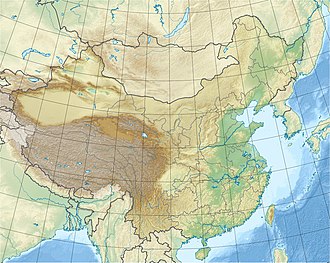| Gyaring Lake | |
|---|---|
 | |
| Coordinates | 34°55′N97°16′E / 34.917°N 97.267°E |
| Type | Fresh water lake |
| Primary inflows | Yellow River, Kari Qu |
| Primary outflows | Yellow River |
| Catchment area | 8,161 km2 (3,151 sq mi) |
| Basin countries | China |
| Max. length | 35 km (22 mi) |
| Max. width | 21.6 km (13 mi) |
| Surface area | 526 km2 (200 sq mi) |
| Average depth | 8.9 m (29 ft) |
| Max. depth | 13.1 m (43 ft) |
| Water volume | 4.67 billion cubic metres (3.79×106 acre⋅ft) |
| Surface elevation | 4,292 m (14,081 ft) |
| Official name | Zhaling Lake |
| Designated | 12 July 2004 |
| Reference no. | 1442 [1] |
Gyaring Lake (Tibetan : མཚོ་སྐྱ་རིང་, Wylie : mtsho skya ring) or Zhaling Lake (Chinese :扎陵湖; pinyin :Zhālíng Hú) is a large freshwater lake in the Yellow River catchment in China, it is in the southeast of Qinghai Province, on the border between Yushu Tibetan Autonomous Prefecture and Golog Tibetan Autonomous Prefecture. The lake's Tibetan name means "Long Gray Lake". Gyaring Lake is 526 km², with a drainage area of 8161 km², an elevation of 4292 m, a length of 35 km and a mean width of 15 km (max 21.6 km). [2]
Contents

